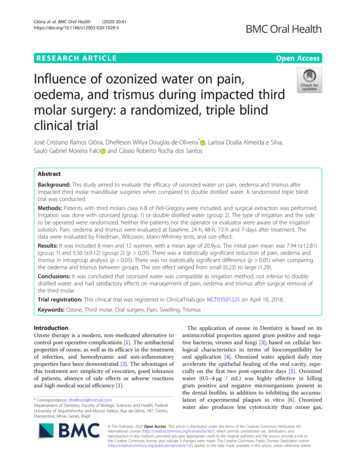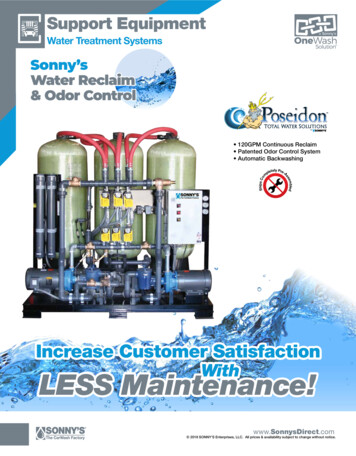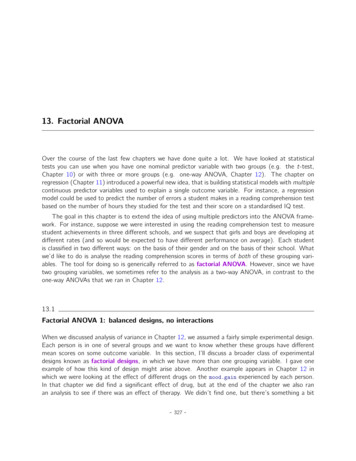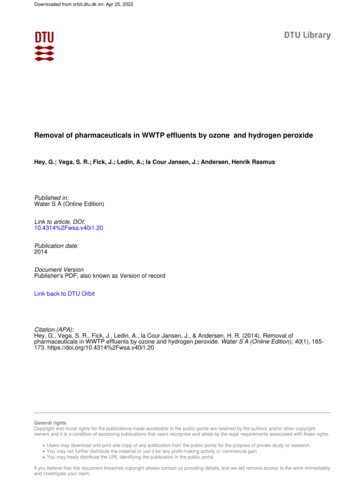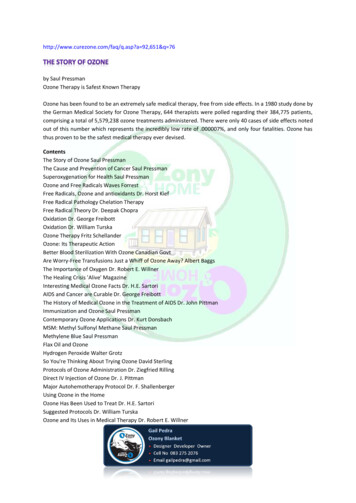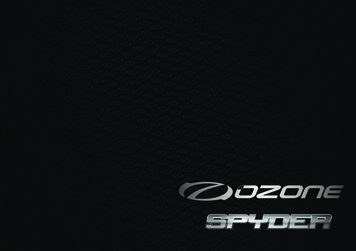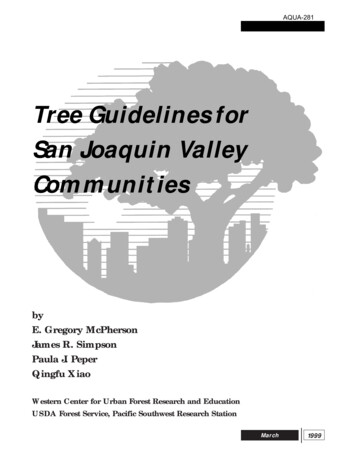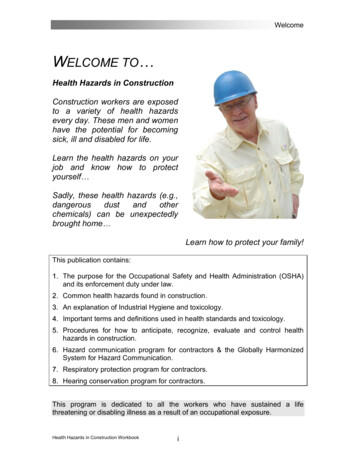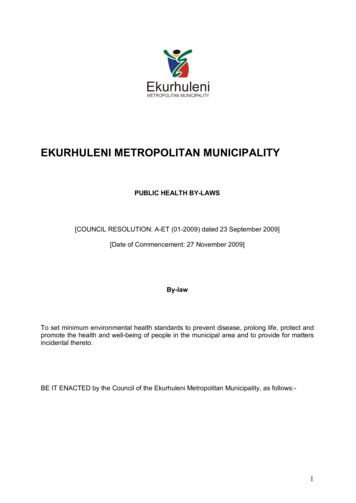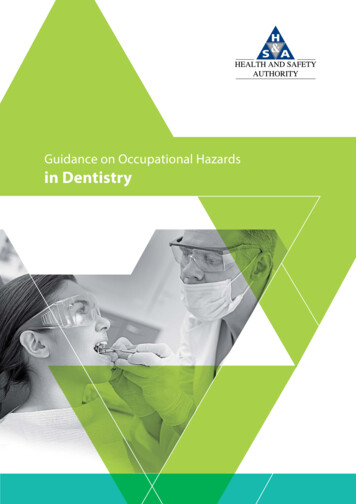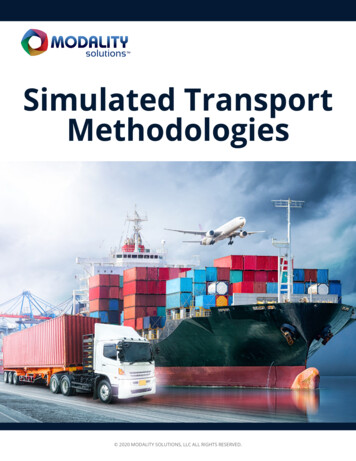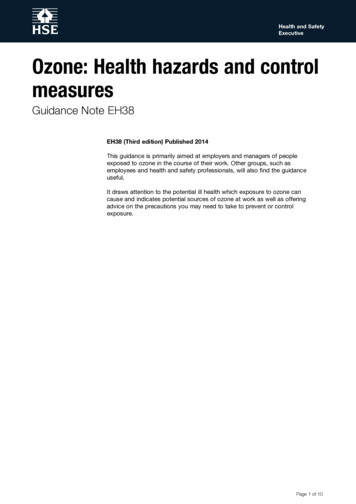
Transcription
Health and SafetyExecutiveOzone: Health hazards and controlmeasuresGuidance Note EH38EH38 (Third edition) Published 2014This guidance is primarily aimed at employers and managers of peopleexposed to ozone in the course of their work. Other groups, such asemployees and health and safety professionals, will also find the guidanceuseful.It draws attention to the potential ill health which exposure to ozone cancause and indicates potential sources of ozone at work as well as offeringadvice on the precautions you may need to take to prevent or controlexposure.Page 1 of 10
Health and SafetyExecutiveContentsIntroduction 3Occurrence and properties 3Effects on health 3Ozone in the workplace 4Complying with the COSHH Regulations 5Prevention and control of exposure 6Maintenance, examination and testing of control measures 7Monitoring exposure 7Reporting symptoms 8First aid 8Information, instruction and training 9Emergency procedures 9Consulting 9References and further reading 9Further information 10Ozone: Health hazards and control measuresPage 2 of 10
Health and SafetyExecutiveIntroduction1 This guidance note is for employers and managers of people exposed to ozonein the course of their work. Other groups, such as employees and health and safetyprofessionals, will also find this guidance useful.2 It draws attention to the potential ill health which exposure to ozone couldcause and indicates potential sources of exposure at work. It gives advice on theprecautions which you may need to take to prevent or control exposure as requiredby the Control of Substances Hazardous to Health Regulations 2002 (COSHH). Itdoes not discuss environmental exposure to ozone or atmospheric ozone-depletingsubstances.3 This guidance should be read in conjunction with the COSHH Approved Codeof Practice (ACOP).1Occurrence and properties4 Ozone (O3) is a form of oxygen. It is a colourless gas with a distinctive odourand is a normal constituent of the earth’s atmosphere. It is about 1.6 times heavierthan air (density 2.144 g/I).5 Ozone is produced naturally from oxygen whenever sufficient ultraviolet (UV)radiation or electrical discharges occur, for example at high altitudes or by theaction of lightning. Such natural occurrences are unlikely to produce hazardousconcentrations at ground level. The majority of ozone found near ground level isformed by photochemical reactions involving oxides of nitrogen and hydrocarbons.6 Ozone is an unstable substance, but its rate of decomposition varies widelydepending on temperature and humidity. A given ozone output which yieldsa faint trace of ozone in a workroom atmosphere on a humid day may createan undesirable concentration on a dry day. These factors are important whenconsidering occupational exposure to ozone.7 Ozone is a powerful oxidising agent and can react explosively with oil and grease.Low concentrations of ozone have a significant effect upon textiles, fabrics, organicdyes, metals, plastics and paints and cause the characteristic cracking of stressedrubber, commonly called ‘weathering’. A few substances, such as glass and somegrades of stainless steel are, however, resistant to the oxidising effects of ozone.8 Ozone is not classified under the Regulation on Classification, Labelling andPackaging of Substances and Mixtures (known as the CLP Regulation). Ozonecannot be stored or transported in vessels because it decomposes spontaneouslyin the presence of oxidisable impurities, humidity and solid surfaces. It is alwaysgenerated in situ, for immediate use, and is extremely unlikely to be supplied as acommodity. Labelling phrases are therefore inappropriate.Effects on health9 Since ozone is a highly reactive substance, any adverse health effects will befound essentially at the sites of initial contact: the respiratory tract (nose, throat andairways), the lungs, and at higher concentrations, the eyes. The principal healtheffects are produced by irritation of and damage to the small airways of the lung.However, people have considerable variation in sensitivity.Ozone: Health hazards and control measuresPage 3 of 10
Health and SafetyExecutive10 Uncontrolled exposure to relatively high levels of ozone could lead to moresevere health effects, including lung damage. At the levels of exposure likely to benormally found in the workplace the main concern is irritation of the (upper) airways,characterised by coughing and a feeling of tightness in the chest.11 This guidance – on establishing effective risk management measures forcontrolling exposure to ozone – focuses on the control of exposure to levels at whichany health effects, if they did occur, would not be significant (see paragraph 28).Ozone in the workplace12 Ozone is produced industrially by bombarding oxygen with UV radiation orby passing air through a high-voltage ac electrical discharge. It is used for a widevariety of industrial purposes including: to improve air quality in offices and as an odour suppresser in hotel bedrooms, commercial kitchens and cafeterias, food and fish processing plants, rubbercompounding plants, chemical plants, sewage treatment works and cold stores;as a disinfectant in the production of drinking water;to overcome taste, odour and peaty colour problems in drinking water;as part of the water treatment process in the removal of pesticides;as a disinfectant in swimming pools and hot and cold water systems;for pre-treatment in coating applications – including inks, wood finishing, metaldecorating and general industrial finishing;for pre-treatment of plastic surfaces immediately before printing;as a bleaching agent in both the textile and foodstuff industries;as a reaction initiator in the chemical industry.Ozone is also produced as an incidental by-product of many industrial activities,some of which are described below.Ultraviolet radiation13 During electric arc welding (specifically TIG and MIG/MAG techniques), metalsare arc welded in the presence of a shielding gas. The UV radiation from the arcproduces significant quantities of ozone, the risks of exposure being particularlysignificant when welding aluminium and stainless steel.14 Ozone is also produced near many types of lamp which emit UV radiation.Such lamps are used in a variety of processes, for example: ink curing: some printing inks, varnishes and lacquers are composed of chemicalsformulated to polymerise rapidly into hard resins upon exposure to UV radiation; projection lamps: high-pressure xenon lamps used in cinema projectors emitsome UV radiation and also produce ozone.High-voltage electrical equipment15 Ozone is also produced around high-voltage equipment and by electricaldischarges in specific processes. Some examples are given below: electrostatic precipitators: these are used to remove dust and some airbornecontaminants from the air where ozone is produced incidentally; static eliminators: these are used in industry to remove static electricity fromrecently moulded plastic articles. The main factor which determines the amountof ozone generated is the voltage across the collector plates; the higher thevoltage the more ozone is produced; X-ray machines.Ozone: Health hazards and control measuresPage 4 of 10
Health and SafetyExecutiveComplying with the COSHH RegulationsThe workplace exposure limit (WEL)16 The current WEL2 for ozone is 0.2 ppm in air averaged over a 15-minutereference period. If exposure to ozone cannot be prevented then the principles ofgood control practice need to be applied (see Schedule 2A of COSHH regulation 7.7)to ensure that the workplace exposure limit is not exceeded.Assessment17 Under COSHH regulation 6, employers must not carry out any work whichis liable to expose any employees to any substance hazardous to health. This isunless they have made suitable and sufficient assessment of the risks created bythat work to the health of those employees and of the steps that need to be takento meet the requirements of COSHH. You will need to carry out a ‘suitable andsufficient’ risk assessment wherever exposure to ozone is likely to occur.18 HSE guidance A step by step guide to COSHH assessment3 describes ingeneral terms how to make an assessment. Guidance is also given in the COSHHACOP. An action plan/checklist for assessment would involve:where is ozone likely to be generated?is exposure likely?who is likely to be exposed?can the exposure be prevented?if the exposure cannot be prevented, estimate the potential level of exposures(in some cases this may involve personal exposure monitoring). If you candemonstrate that your estimate of exposure is unlikely to exceed the WEL, youdo not need to take any further action; if exposures exceed or are likely to exceed the WEL, decide what controlmeasures are needed and take appropriate action. The assessment must be reviewed regularly.Low-risk work activities19 With some work activities, there may be exposure to small amounts of ozonethat is without any significant risk to health. These low-risk work activities are mainlyencountered in office-type environments. They include working with most typesof photocopiers, printers, projectors, X-ray machines (all types: medical, dental,industrial), and some types of room deodoriser.20 The risks to health are slight – and in general any symptoms shown will beirritation of the respiratory tract. However, employers should be aware that itis possible in certain cases to build up levels of ozone in excess of the WEL ininadequately ventilated rooms (see paragraph 16).21 Manufacturers and suppliers should provide recommendations on the sitingand use of such equipment, and in normal use it is unlikely that you will need domore than comply with the recommendations to ensure the WEL is not exceeded.The preferred option is to put the equipment in a dedicated room. Where this isnot practicable, it may be necessary to site the equipment in a well-ventilated area.However, if it is not sited in accordance with the manufacturer’s recommendationsyou should make a more detailed assessment of the potential risks.22 Ozone oxidises airborne organic matter and inhibits the growth of bacteria(although it does not kill them). To use this effect, slow-output ozone generatorsare often used to improve air quality in offices or to act as a commercial odoursuppressor. These generators emit small quantities of ozone: you should assess themost appropriate siting and ventilation in the same way as for printers and copiers.Ozone: Health hazards and control measuresPage 5 of 10
Health and SafetyExecutive23 Employers need to ensure that, where appropriate, their employees are awareof the precautions required to reduce the risks from exposure to ozone, and thecontrol measures that are used. Employees should be told to report any obviousproblems – such as a closed ventilation window in a copier room – to theirsupervisor or employer.24 If your risk assessment shows that these are the only sources of ozone in yourworkplace, and you have followed the above guidance, then you need only keepthese measures under review to comply with COSHH.Higher-risk work activities25 COSHH requires that precautions should be taken for the protection of everyemployee who may be exposed to hazardous substances. In the case of ozone,experience shows that certain work activities described in paragraphs 12 to 15 willpresent a significant potential for exposure. Such exposures to higher levels of ozonecan cause serious health effects and present a higher risk to people. The controlmeasures employers need to take are explained in detail in the rest of this guidance.Prevention and control of exposure26 The COSHH Regulations require employers to ensure that the exposure of theiremployees to substances hazardous to health is either prevented or, where this isnot reasonably practicable, adequately controlled.27 The advice in the following paragraphs should help you when consideringprevention and/or control procedures. These should be adapted to suit localconditions. Arrangements should be made to review the adequacy of precautionstaken, particularly if the circumstances of use change or in the light of new technicaldevelopments. For instance, the continued use of static eliminators in poorlyventilated rooms can cause a build up of ozone above the WEL.Prevention of exposure28 Prevention of exposure to ozone should be the preferred approach. Formany processes, the release of ozone into the workplace can be prevented orsubstantially reduced by its destruction at source.Control measures29 Adequate control should be achieved, as far as reasonably practicable, by theuse of process or engineering controls. Where these measures are not adequate,you should consider further controls, such as improved systems of work and theuse of respiratory protective equipment. Whatever controls are chosen, there is aneed to check that they are effective and remain effective.Engineering control30 Engineering control measures will vary depending on the requirements of eachworkplace. The following methods will adequately encompass most situations: Where the source of ozone emission can be defined, for instance the use ofUV lamps in ink curing, it may be reasonably practicable to use local exhaustventilation (LEV) close to the source of the emission (with UV lamps this is thelamp enclosure). This prevents or significantly reduces the amount of ozoneentering the workroom air. Extracted air may need to be passed through anappropriate filter to remove the ozone before discharge. Where the source of ozone is less well defined, or the use of LEV is notreasonably practicable, the workroom should be equipped with adequategeneral ventilation.Ozone: Health hazards and control measuresPage 6 of 10
Health and SafetyExecutive In plant rooms, where ozone is generated, it is recommended that there issufficient ventilation to allow potentially dangerous accumulations of gas to berapidly dispersed. Arc weld shielding gases that are specifically formulated to reduce ozonelevels are widely available and are the preferred choice over ‘general purpose’shielding gases. Further guidance on controlling exposure to welding gases andfume is available on the HSE welding webpages at www.hse.gov.uk/welding.Respiratory protective equipment (RPE)31 There will be situations where other control measures are either not reasonablypracticable or fail to achieve adequate control. In these circumstances the use ofRPE in addition to any other controls is a valid strategy. For instance, it may benecessary to use RPE when dealing with an ozone leak from a generator, or whenundertaking inert gas shrouded welding operations on production plant.32 The RPE selected should be adequate and suitable for the environment andthe user and manufactured to an appropriate standard. Employees should beproperly trained in its use, fit tested for tight-fitting respirators and supervised.The equipment should be appropriately stored, regularly cleaned and checked toensure that it remains effective. Further guidance on the selection and use of RPEis contained in Respiratory protective equipment at work: A practical guide.4Maintenance, examination and testing of control measures33 Regulation 9 of COSHH requires that every employer who provides any controlmeasure to meet the requirements of regulation 7 must ensure that it is maintainedin an effective state, in an efficient working order and in good repair.34 To comply with regulation 9 you should ensure that: all plant and equipment used to control exposure to ozone are maintainedin an efficient state, in efficient working order, in good repair and in a cleancondition (the manufacturer/supplier of the plant should be able to help you withappropriate information); safe systems of work, supervision and any other control measures are reviewedat suitable intervals and revised if necessary; competent persons undertake frequent visual checks and periodically carry outthorough examinations of the plant and equipment to ensure they are beingmaintained adequately; all LEV plant is examined and tested at least every 14 months (a record of suchtests must be kept for at least five years after the date on which they were made).35 Further general information about LEV is available on the HSE website atwww.hse.gov.uk/lev and in Controlling airborne contaminants at work: A guide tolocal exhaust ventilation (LEV) HSG258.5Monitoring exposure36 The results of a COSHH assessment will help you decide whether there is aneed to carry out monitoring. When the COSHH assessment indicates that theremight be wide variations of exposure at certain times and in certain operations, thenyou may need to measure exposure to confirm that engineering control is adequateto maintain the exposure at or below the WEL. Any monitoring regime should beplanned carefully, and the advice of an occupational hygienist could prove to beuseful. For more advice see : Health hazards and control measuresPage 7 of 10
Health and SafetyExecutiveDetector tubes37 Short-term detector tubes capable of measuring ozone are available from anumber of manufacturers. They provide an inexpensive and simple method forestimating the concentration of ozone in workplace air over a short time period,and can therefore be useful for making screening measurements to identify peakexposures or potential leaks from machines or control equipment. However, it isgenerally not valid to use detector tube measurements to calculate time-weightedaverage exposures for comparison with the WEL. Also, ozone measurements madewith detector tubes can be relatively imprecise and are susceptible to positiveinterference from other oxidising agents, for example chlorine and nitrogen dioxide.38 For personal monitoring the use of a direct-reading instrument is recommendedwhen assessing the pattern and duration of exposure.Direct-reading instruments39 A range of direct-reading instruments for measuring ozone are availablecommercially. Many are fixed-site or transportable instruments that are only suitablefor source characterisation and making background screening measurements.However, there are some portable instruments available that are suitable formeasuring personal exposure in addition to source characterisation, screeningmeasurements and checking the effectiveness of controls. Since direct-readinginstruments are continuously reading, they can be used for making measurementsof time-weighted average exposure over short-term (15 minutes) or long-term(8 hour) reference periods for comparison with the WEL.Reporting symptoms40 Employees should be made aware of the possibility of exposure to ozone, andshould be encouraged to inform their employer and their doctor if they developany respiratory problems. People with allergic conditions such as asthma or hayfever might form a sensitive group in which exposure to ozone could worsen theircondition.First aid41 If someone is overcome by ozone, the following precautions should beadopted:(a) Remove the person to a warm uncontaminated atmosphere and loosen tightclothing at the neck and waist.(b) Keep the person at rest.(c) If the person has difficulty in breathing, oxygen can be administered by acompetent individual using the appropriate equipment. A competent individualis an occupational health professional or workplace first aider who has receivedtraining in oxygen administration and whose competency is assessed on aregular basis.(d) If the person is not breathing normally then start cardiopulmonary resuscitation.Individuals undertaking this action should be either first aiders who holda current qualification in workplace first aid or are occupational healthprofessionals considered competent in accordance with the current basic and/or advanced resuscitation protocols of the UK Resuscitation Council.(e) Seek medical help.Ozone poisoning should be treated symptomatically. A period of medicalobservation may be necessary because of the risk of delayed lung damage.Ozone: Health hazards and control measuresPage 8 of 10
Health and SafetyExecutiveInformation, instruction and training42 To comply with regulation 12 of COSHH, employers should give all theiremployees who may be exposed to ozone at work sufficient information, instructionand training to understand the risks to their health caused by exposure to ozoneand the precautions which should be taken to avoid or minimise exposure. Forexample welders may be unaware that the UV radiation from the arc generatesozone and that they could be exposed to it. Employers should provide adequatesupervision, particularly to new and inexperienced workers.43 The training should include details on how control measures are to beused. Employees should be told to report any obvious defects in the controlmeasures to their supervisor. Where RPE is used employees should be trainedto check that it fits properly, and given clear instructions about when it should beused, serviced (including frequency of filter changing), cleaned, stored or, if it isdisposable, thrown away.Emergency procedures44 Emergency action plans should be prepared for all sites where ozone isgenerated in potentially hazardous quantities. Where leaks from pipes or equipmentare detected, ozonators should be capable of being shut down if abnormaloperating conditions prevail (for example air drier failure, cooling water failure,excess system pressure). In the event of an ozone leak do not attempt a plantrestart until the source of leakage has been identified and rectified. Leak detectionby nose is not satisfactory because even slight leaks cause the sensation of smellto be numbed and lead to the false conclusion that a leak no longer exists.45 Appropriate warning signs indicating the presence of a potential toxic gashazard should be displayed on ozone plant access doors or in passagewaysleading to the plant room.Consulting46 You must consult all your employees, in good time, on health and safetymatters. In workplaces where a trade union is recognised, this will be through unionhealth and safety representatives. In non-unionised workplaces, you can consulteither directly or through other elected representatives.References and further readingReferences1 Control of substances hazardous to health (COSHH). The Control ofSubstances Hazardous to Health Regulations 2002 (as amended). ApprovedCode of Practice and guidance L5 (Sixth edition) HSE Books 2013ISBN 978 0 7176 6582 2 www.hse.gov.uk/pubns/books/l5.htm2 EH40/2005 Workplace exposure limits: Containing the list of workplaceexposure limits for use with the Control of Substances Hazardous to HealthRegulations (as amended) Environmental Hygiene Guidance Note EH40(Second edition) HSE Books 2011 ISBN 978 0 7176 6446 7www.hse.gov.uk/pubns/books/eh40.htm3 A step by step guide to COSHH assessment HSG97 (Second edition)HSE Books 2004 ISBN 978 0 7176 2785 1www.hse.gov.uk/pubns/books/hsg97.htmOzone: Health hazards and control measuresPage 9 of 10
Health and SafetyExecutive45Respiratory protective equipment at work: A practical guide HSG53(Fourth edition) HSE Books 2013 ISBN 978 0 7176 6454 2www.hse.gov.uk/pubns/books/hsg53.htmControlling airborne contaminants at work: A guide to local exhaust ventilation(LEV) HSG258 (Second edition) HSE Books 2011 ISBN 978 0 7176 6415 3www.hse.gov.uk/pubns/books/hsg258.htmFurther readingUS Occupational Safety and Health Administration OSHA Analytical MethodsManual 2nd Edition Method 10-214: Ozone in work place atmospheres(impregnated glass fiber filter) USDOUOSHA Salt Lake City 1995Monitoring strategies for toxic substances HSG173 (Second edition) HSE Books2006 ISBN 978 0 7176 6188 6 www.hse.gov.uk/pubns/books/hsg173.htmCOSHH Health surveillance information available her informationFor information about health and safety, or to report inconsistencies or inaccuraciesin this guidance, visit www.hse.gov.uk/. You can view HSE guidance online andorder priced publications from the website. HSE priced publications are alsoavailable from bookshops.This guidance is issued by the Health and Safety Executive. Following the guidanceis not compulsory, unless specifically stated, and you are free to take other action.But if you do follow the guidance you will normally be doing enough to comply withthe law. Health and safety inspectors seek to secure compliance with the law andmay refer to this guidance.This document is available at: www.hse.gov.uk/pubns/eh38.htm Crown copyright If you wish to reuse this information visitwww.hse.gov.uk/copyright.htm for details. First published 03/14.Published by the Health and Safety ExecutiveEH38 (Third edition)03/14Page 10 of 10
Ozone: Health hazards and control measures Guidance Note EH38 EH38 (Third edition) Published 2014 . ACOP. An action plan/checklist for assessment would involve: . are often used to improve air quality in offices or to act as a commercial odour suppressor. These generators emit small quantities of ozone: you should assess the
